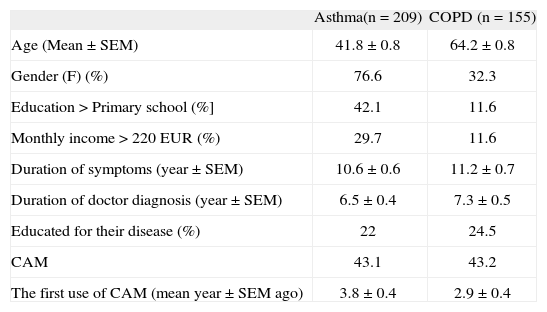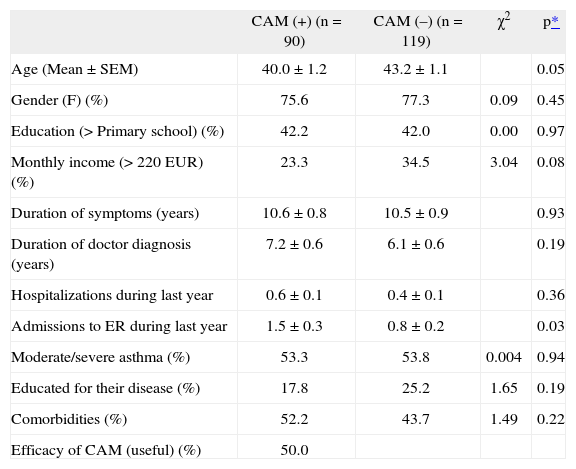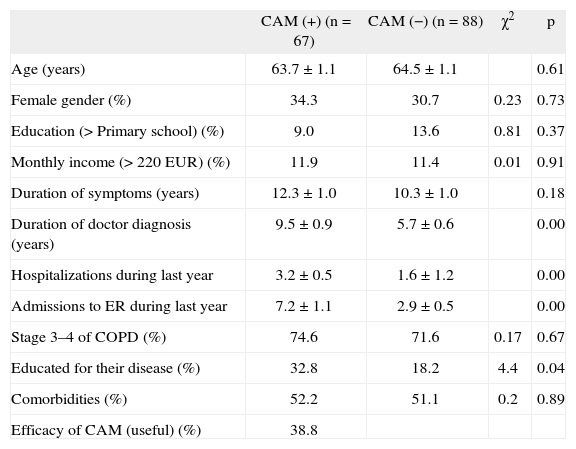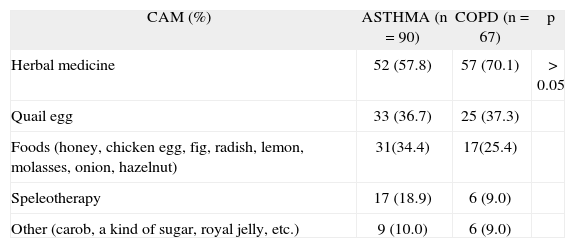The popularity of complementary and alternative medicine (CAM), particularly for chronic diseases such as asthma, is growing rapidly, but little is known about the characteristics of CAM use by patients with asthma and chronic obstructive pulmonary diseases (COPD). The aim of the present study is to compare the knowledge and preferences of patients with asthma or COPD about CAM, to evaluate the extent, characteristics and possible predictors of CAM use.
MethodsA face-to-face interview questionnaire was administered to the patients who attended the Allergic Diseases and Chest Diseases clinics between May 2005-January 2006, and 364 patients answered the questionnaire.
Results43.1% (n = 90) of the 209 asthmatic patients, and 43.2 % (n = 67) of the 155 COPD patients had used some type of CAM previously. The asthmatic patients who have been admitted to the Emergency Room(ER) more frequently tend to use CAM methods (p = 0.03), whereas duration of doctor diagnosis, hospitalizations, admissions to ER and to be educated for diseases have a higher impact on CAM use in COPD patients (p = 0.00, p = 0.00, p = 0.00 and p = 0.04, respectively). The most commonly used forms of CAM were herbal medicines (57.8% vs. 70.1 %) and quail egg (46.7 % vs. 37.3 %) in patients with asthma and COPD, respectively. The reported frequency of the subjective sense of improvement was higher in asthmatic patients than COPD patients but this difference was insignificant (50.0%vs.39.4 %; p = 0.24).
ConclusionMost of the patients with asthma or COPD prefer alternative medicine. CAM use by patients with COPD should be asked about by their doctors, strongly advised about continuing their medicines and about side effects of CAM.
Complementary and alternative medicine (CAM) has been used for decades in the management of diseases. Despite all the recent developments in pharmacological therapies, the use of CAM is, surprisingly, increasing. Incidence reports of herbal product (HP) use in the general US population vary, ranging from 12.1 % to as much as 59 % in certain areas along the US/Mexico border1. CAM interventions are most commonly used for chronic diseases. Asthma is one of a number of common disorders for which there is a varied literature in support of CAM therapies. One of the earliest documented CAM interventions in the treatment of asthma is from Maimonides, who dedicated an entire treatise on asthma that provides several treatment formulations, including an enema composed of sap of linseed or fenugreek or both, with oil and chicken fat and a mixture of beet juice and chicken or fat hen soup. Currently, atopic diseases that include asthma continue to be some of the most common disorders for which many patients seek CAM interventions2,3.
Chronic obstructive pulmonary diseases (COPD) are a group of conditions characterized by chronic airway obstruction. Unsatisfactory treatment outcomes from conventional drugs, and adverse effects associated with several classes of drugs, such as steroids and theophylline, contribute substantially to the increasing popularity of CAM and, in particular, herbal medicine. There is a long history of using herbal remedies to treat COPD, particularly in China, India and other Asian countries4.
Although many reported studies are addressed to CAM practices in the world, we could find only a few data about CAM usage and comparison for asthma and COPD in Turkey.
The purpose of this study is to compare the knowledge of patients with asthma or COPD about alternative medicines and their preferences, and to analyse their relations with social, economical and demographic characteristics of two groups.
MATERIALS AND METHODSPatient selectionThe study was conducted in Cumhuriyet University, Faculty of Medicine, Allergic Diseases and Chest Diseases clinics in Sivas from May 2005-January 2006. Asthma was diagnosed clinically by the presence of recurrent symptoms of wheezing, shortness of breath, cough, and demonstration of objective signs of reversible airway obstruction as stated by a recent guideline5. COPD was defined and classified according to the Global Initiative for Chronic Obstructive Lung Disease (GOLD) guideline -updated 2005 version6.
Atopy diagnosisAtopy was defined as the positive skin prick test response to common aeroallergens (a wheal size ≥ 3mm); Dermatophagoides pteronyssinus, D. farinae, a mixture of grasses pollens, a mixture of weeds pollens, a mixture of trees pollens, a mixture of cereal pollens, a mixture of moulds and animal epithelia (cat and dog) (Stallergenes SA, Pasteur, France). Histamine phosphate was used as positive control and serum physiologic as negative control.
QuestionnaireA face-to-face interview questionnaire was administered to the patients which was specifically designed for the study on the use of CAM including quail hen; herbal products; animal products; psycho-religious methods; acupuncture; yoga; hypnosis; massage therapies; Turkish-baths; and speleotherapy for the cure of their diseases. All subjects were asked about their monthly family income, education level, social insurance, comorbid diseases, the duration of symptoms and doctor diagnosis, number of hospitalizations and emergency room visits, educated or not about their diseases.
In addition, the duration of alternative medicine, usage history, their opinions about the effects of CAM as being useful or not, the way of learning of CAM, the cause of preference of CAM and advice or not from other people were all asked.
Statistical analysesStatistically analyses were carried out using the Statistical Package for the Social Sciences version 10.0 for Windows (SPSS Inc, Chicago, IL, USA). Results of the study are presented as the mean ± SEM. Univariate analysis to estimate differences and 95 % confidence intervals (95 % CI) between comparison groups included Pearson chi-square tests for categorical variables. The χ2 test and Student'st-test were used to detect differences between groups; p < 0.05 was considered significant. Pearson's correlations were used to assess relationships between variables.
Ethical approvalInstitutional ethics approval was obtained from Cumhuriyet University Ethics Committee.
RESULTSA total of 364 patients (154 male, 210 female, mean age 51.3 ± 0.8) were enrolled in the study. The percentages of patients with asthma and COPD in the study group were 57.4 % (n = 209) and 42.6 % (n = 155), respectively.
Characteristics of patientsBaseline characteristics of patients in each group and rate of CAM use are shown in Table I. The overall use of CAM was 42.9 % (156 patients). There was no gender difference with regard to the use of CAM (41.7 % versus 58.3 %; χ2 = 0.83, p > 0.05).
Demographic characteristics of patients
| Asthma(n = 209) | COPD (n = 155) | |
| Age (Mean ± SEM) | 41.8 ± 0.8 | 64.2 ± 0.8 |
| Gender (F) (%) | 76.6 | 32.3 |
| Education > Primary school (%] | 42.1 | 11.6 |
| Monthly income > 220 EUR (%) | 29.7 | 11.6 |
| Duration of symptoms (year ± SEM) | 10.6 ± 0.6 | 11.2 ± 0.7 |
| Duration of doctor diagnosis (year ± SEM) | 6.5 ± 0.4 | 7.3 ± 0.5 |
| Educated for their disease (%) | 22 | 24.5 |
| CAM | 43.1 | 43.2 |
| The first use of CAM (mean year ± SEM ago) | 3.8 ± 0.4 | 2.9 ± 0.4 |
The characteristics of patients with asthma and COPD who use CAM are shown in tables II-III. We found that the use of CAM by patients with COPD was correlated with the duration of doctor diagnosis (r = 0.28, p < 0.01); the number of hospitalizations (r = 0.28, p < 0.01); and admission to the Emergency Room (ER) during the previous year (r = 0.28, p < 0.01).
The characteristics of patients with asthma who use CAM
| CAM (+) (n = 90) | CAM (–) (n = 119) | χ2 | p* | |
| Age (Mean ± SEM) | 40.0 ± 1.2 | 43.2 ± 1.1 | 0.05 | |
| Gender (F) (%) | 75.6 | 77.3 | 0.09 | 0.45 |
| Education (> Primary school) (%) | 42.2 | 42.0 | 0.00 | 0.97 |
| Monthly income (> 220 EUR) (%) | 23.3 | 34.5 | 3.04 | 0.08 |
| Duration of symptoms (years) | 10.6 ± 0.8 | 10.5 ± 0.9 | 0.93 | |
| Duration of doctor diagnosis (years) | 7.2 ± 0.6 | 6.1 ± 0.6 | 0.19 | |
| Hospitalizations during last year | 0.6 ± 0.1 | 0.4 ± 0.1 | 0.36 | |
| Admissions to ER during last year | 1.5 ± 0.3 | 0.8 ± 0.2 | 0.03 | |
| Moderate/severe asthma (%) | 53.3 | 53.8 | 0.004 | 0.94 |
| Educated for their disease (%) | 17.8 | 25.2 | 1.65 | 0.19 |
| Comorbidities (%) | 52.2 | 43.7 | 1.49 | 0.22 |
| Efficacy of CAM (useful) (%) | 50.0 |
Numerical variables expressed in mean ± SD.
ER: Emergency room.
The characteristics of patients with COPD who use CAM
| CAM (+) (n = 67) | CAM (−) (n = 88) | χ2 | p | |
| Age (years) | 63.7 ± 1.1 | 64.5 ± 1.1 | 0.61 | |
| Female gender (%) | 34.3 | 30.7 | 0.23 | 0.73 |
| Education (> Primary school) (%) | 9.0 | 13.6 | 0.81 | 0.37 |
| Monthly income (> 220 EUR) (%) | 11.9 | 11.4 | 0.01 | 0.91 |
| Duration of symptoms (years) | 12.3 ± 1.0 | 10.3 ± 1.0 | 0.18 | |
| Duration of doctor diagnosis (years) | 9.5 ± 0.9 | 5.7 ± 0.6 | 0.00 | |
| Hospitalizations during last year | 3.2 ± 0.5 | 1.6 ± 1.2 | 0.00 | |
| Admissions to ER during last year | 7.2 ± 1.1 | 2.9 ± 0.5 | 0.00 | |
| Stage 3–4 of COPD (%) | 74.6 | 71.6 | 0.17 | 0.67 |
| Educated for their disease (%) | 32.8 | 18.2 | 4.4 | 0.04 |
| Comorbidities (%) | 52.2 | 51.1 | 0.2 | 0.89 |
| Efficacy of CAM (useful) (%) | 38.8 |
Numerical variables expressed in mean ± SD.
*p < 0.05: Statistically significant.
ER: Emergency room.
The mean first use of CAM time was 3.8 ± 0.4 and 2.9 ± 0.4years ago in patients with asthma and COPD, respectively. There was no statistically significant difference between the two groups. 54.4 % of asthmatic patients and 58.2 % of patients with COPD used CAM more than two times. The difference was not significant (X2 = 0.22, p = 0.64), The duration of CAM use was equal to or longer than 1month in 53.3 % of asthmatics and 66.1 % of patients with COPD (X2 = 2.5, p = 0.12).
The reported frequency of the subjective sense of improvement was higher in asthmatics than in COPD patients but this difference was not significant (50.0 % vs. 39.4 %; X2 = 2.9, p = 0.24).
The percentages of patients who reported having heard about the use of CAM from friends-relatives were 34.0 % vs. 32.3 % in patients with asthma and COPD, respectively.
The most frequent reason for using CAM was the expectation of improvement in COPD patients (20.0 %); and the recommendation by someone in asthmatic patients (14.4%). The percentages of patients who reported that they advised someone to use CAM were 18.1 % and 13.4 % in patients with COPD and asthma, respectively (X2 = 1.5, p = 0.22).
The prevalence of different kinds of CAM in asthmatic patients is summarized in Table IV. The most popular forms of CAM were herbs, quail egg and foods. Of the foods, honey was the most preferred as CAM in patients with asthma and COPD (24.4 % and 16.4%, respectively). Subjectively, 48.1 %, 54.5 % and 58.1 % of the asthmatic patients evaluated the efficacy of herbs, quail egg and foods as useful, respectively. In COPD patients these rates were 40.4%, 40.0% and 29.4%, respectively. These differences were not statistically significant.
Use of CAM by patients
| CAM (%) | ASTHMA (n = 90) | COPD (n = 67) | p |
| Herbal medicine | 52 (57.8) | 57 (70.1) | > 0.05 |
| Quail egg | 33 (36.7) | 25 (37.3) | |
| Foods (honey, chicken egg, fig, radish, lemon, molasses, onion, hazelnut) | 31(34.4) | 17(25.4) | |
| Speleotherapy | 17 (18.9) | 6 (9.0) | |
| Other (carob, a kind of sugar, royal jelly, etc.) | 9 (10.0) | 6 (9.0) |
*p < 0.05: Statistically significant.
ER: Emergency room.
This is the first Turkish study to compare the view about CAM in patients with asthma and COPD. There is little evidence comparing CAM use in asthma and COPD. We found that use of CAM preparations by patients with asthma and COPD was equal.
Asthmatic patientsStudies have shown that the prevalence of CAM use in asthmatics varies from 8 % to 70 %7–9. Similar to these results, 43.1 % of our asthmatic patients had used CAM.
This study showed that younger asthmatic patients use CAM slightly more often. This is in accordance with findings in the general population of Europe10. ER admittances during the previous year were significantly high in asthmatic CAM users. This also agrees with previous findings11.
The prevalence of CAM use was insignificant between atopic and nonatopic asthmatic patients (38.6 % vs. 37.9 %, respectively). Similarly, the previous study did not detect significant differences in atopic and nonatopic asthmatics7.
Several types of CAM have been used in the treatment of asthma. These modalities include acupuncture; homeopathy; yoga; breathing exercises; relaxation therapies; nutritional therapies; and herbal products2. This study showed that the most common preferred method of CAM was herbal medicine (57.8 %) in asthmatic patients. They had used herbal medicine with or without different CAM types. This rate was higher than in previous studies also investigating CAM for asthma1711,12. One of the important findings in our study is that, unlike other European countries, quail egg was the one of the most popular types of CAM in the asthmatic population (36.9 %). Although quail egg use was less in our previous study7, this finding was consistent with another study from Turkey11. In our study, some kinds of foods were used as CAM by asthmatic patients. These differences might be due to variations between cultures according to general beliefs, religions, and geographical characteristics which may affect the growth of special types of plants or animals.
COPD PatientsIn our study, the percentage of CAM use in COPD patients was consistent with a previous study13. Age, sex and education levels of patients who used CAM were not significantly different from that of non-users as was reported in the afore-mentioned study.
We found that the duration of doctor diagnosis, the number of hospitalizations and admissions to ER during the last year were higher in CAM user COPD patients. It might be due to the fact that COPD is, unlike asthma, a chronic irreversible and progressive disease. Therefore, because of failure of treatment, the patient with COPD might need other medicines. The CAM users with COPD sought education about their diseases. It might be effective to make patients aware of other treatment modalities. In our study, patients with COPD showed a similar tendency to asthma patients by using herbal products as the main alternative treatment method. The present study showed that 38.8 % of COPD patients evaluated the efficacy of CAM as useful. Several herbal remedies with the potential to improve pulmonary function, to relieve symptoms or to reduce exacerbation severity and frequency were identified in the treatment of COPD. However, the effectiveness of herbal remedies for treating COPD has not been established4. Despite the popularity of CAM, we could not find any comprehensive study evaluating patient characteristics of CAM users for treating COPD.
Our study has several limitations. We relied on self-reporting by patients and our findings were not verified against any objective measures. According to our knowledge there are no data about the use of CAM in patients with COPD in Turkey so we were unable to compare our data with other studies.
In conclusion, we conclude that CAM is widely used in the population to treat asthma and COPD. The asthmatic patients who were more frequently admitted to ER tend to use CAM methods more frequently; whereas the duration of doctor diagnosis, hospitalizations, admissions to ER and to be educated for diseases have a higher impact on CAM use in COPD patients. There seem to be national peculiarities concerning CAM methods. Unlike in other countries, the quail egg is used as a type of CAM by patients in asthma and COPD in Turkey. In the light of this data; physicians dealing with COPD patients should ask and discuss this CAM use for their patients as well as asthmatics.








